technical specifications FIAT CROMA 2008 2.G Owners Manual
[x] Cancel search | Manufacturer: FIAT, Model Year: 2008, Model line: CROMA, Model: FIAT CROMA 2008 2.GPages: 258, PDF Size: 5.86 MB
Page 135 of 258
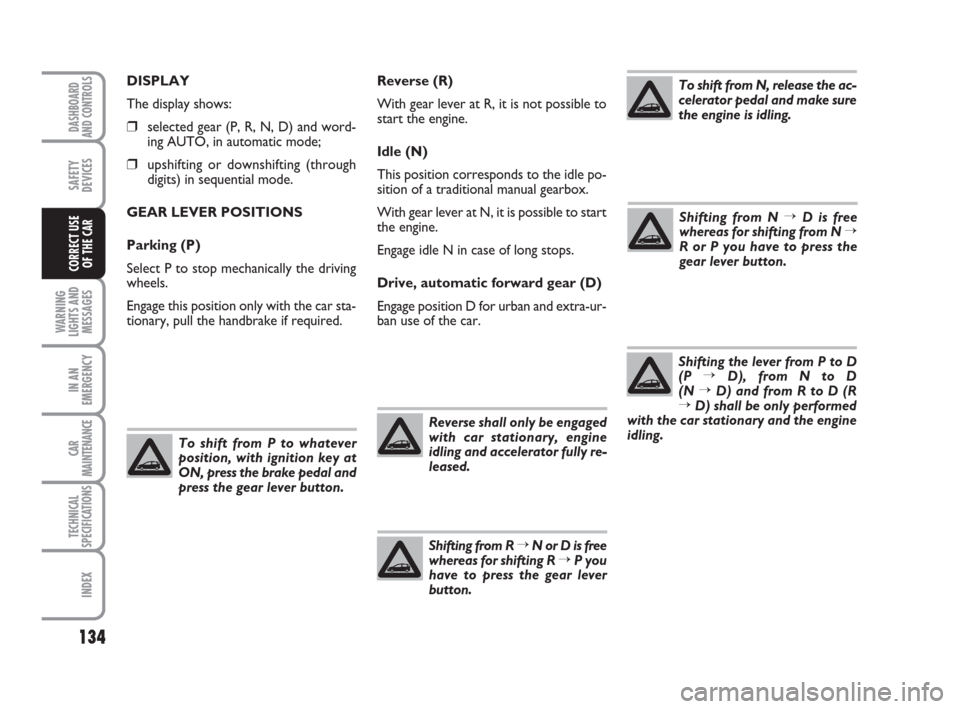
Reverse (R)
With gear lever at R, it is not possible to
start the engine.
Idle (N)
This position corresponds to the idle po-
sition of a traditional manual gearbox.
With gear lever at N, it is possible to start
the engine.
Engage idle N in case of long stops.
Drive, automatic forward gear (D)
Engage position D for urban and extra-ur-
ban use of the car. DISPLAY
The display shows:
❒selected gear (P, R, N, D) and word-
ing AUTO, in automatic mode;
❒upshifting or downshifting (through
digits) in sequential mode.
GEAR LEVER POSITIONS
Parking (P)
Select P to stop mechanically the driving
wheels.
Engage this position only with the car sta-
tionary, pull the handbrake if required.
134
WARNING
LIGHTS AND
MESSAGES
IN AN
EMERGENCY
CAR
MAINTENANCE
TECHNICAL
SPECIFICATIONS
INDEX
DASHBOARD
AND CONTROLS
SAFETY
DEVICES
CORRECT USE
OF THE CAR
To shift from P to whatever
position, with ignition key at
ON, press the brake pedal and
press the gear lever button.
Reverse shall only be engaged
with car stationary, engine
idling and accelerator fully re-
leased.
Shifting from R →N or D is free
whereas for shifting R →P you
have to press the gear lever
button.
To shift from N, release the ac-
celerator pedal and make sure
the engine is idling.
Shifting from N →D is free
whereas for shifting from N →R or P you have to press the
gear lever button.
Shifting the lever from P to D
(P →D), from N to D
(N →D) and from R to D (R→D) shall be only performed
with the car stationary and the engine
idling.
127-144 Croma TRW GB 28-05-2008 16:32 Pagina 134
Page 136 of 258
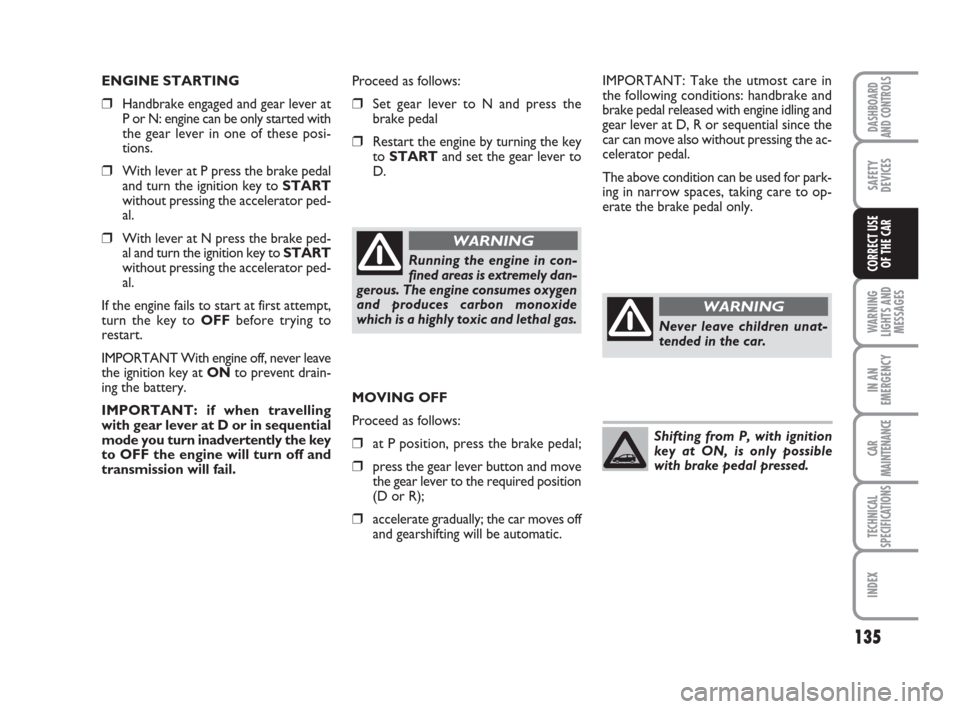
Proceed as follows:
❒Set gear lever to N and press the
brake pedal
❒Restart the engine by turning the key
to STARTand set the gear lever to
D.IMPORTANT: Take the utmost care in
the following conditions: handbrake and
brake pedal released with engine idling and
gear lever at D, R or sequential since the
car can move also without pressing the ac-
celerator pedal.
The above condition can be used for park-
ing in narrow spaces, taking care to op-
erate the brake pedal only. ENGINE STARTING
❒Handbrake engaged and gear lever at
P or N: engine can be only started with
the gear lever in one of these posi-
tions.
❒With lever at P press the brake pedal
and turn the ignition key to START
without pressing the accelerator ped-
al.
❒With lever at N press the brake ped-
al and turn the ignition key to START
without pressing the accelerator ped-
al.
If the engine fails to start at first attempt,
turn the key to OFFbefore trying to
restart.
IMPORTANT With engine off, never leave
the ignition key at ONto prevent drain-
ing the battery.
IMPORTANT: if when travelling
with gear lever at D or in sequential
mode you turn inadvertently the key
to OFF the engine will turn off and
transmission will fail.
135
WARNING
LIGHTS AND
MESSAGES
IN AN
EMERGENCY
CAR
MAINTENANCE
TECHNICAL
SPECIFICATIONS
INDEX
DASHBOARD
AND CONTROLS
SAFETY
DEVICES
CORRECT USE
OF THE CARRunning the engine in con-
fined areas is extremely dan-
gerous. The engine consumes oxygen
and produces carbon monoxide
which is a highly toxic and lethal gas.
WARNING
MOVING OFF
Proceed as follows:
❒at P position, press the brake pedal;
❒press the gear lever button and move
the gear lever to the required position
(D or R);
❒accelerate gradually; the car moves off
and gearshifting will be automatic.
Never leave children unat-
tended in the car.
WARNING
Shifting from P, with ignition
key at ON, is only possible
with brake pedal pressed.
127-144 Croma TRW GB 28-05-2008 16:32 Pagina 135
Page 137 of 258
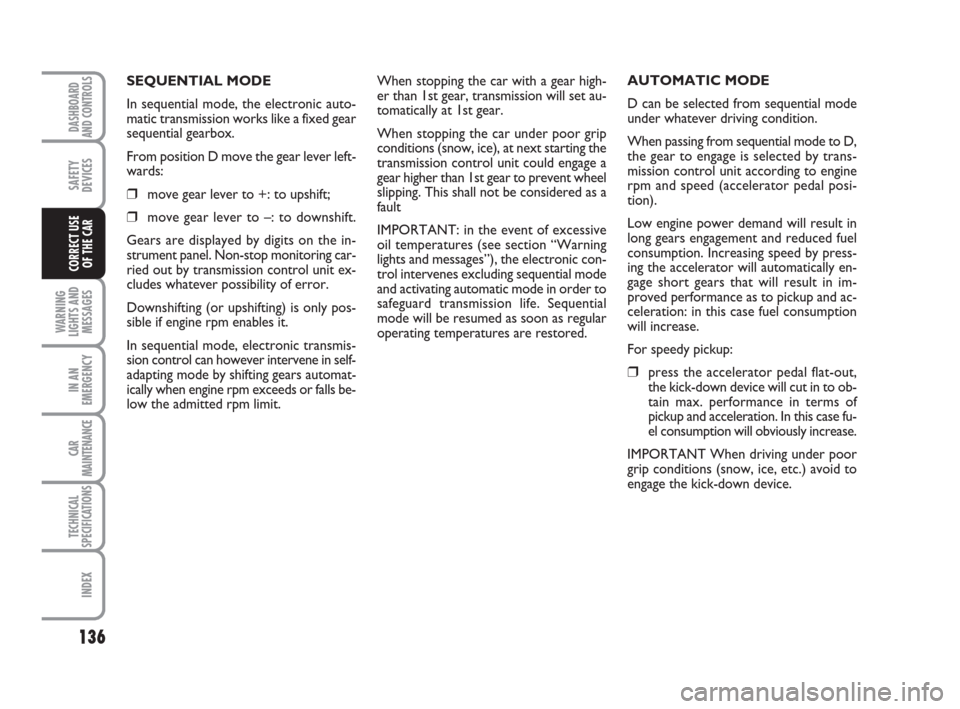
When stopping the car with a gear high-
er than 1st gear, transmission will set au-
tomatically at 1st gear.
When stopping the car under poor grip
conditions (snow, ice), at next starting the
transmission control unit could engage a
gear higher than 1st gear to prevent wheel
slipping. This shall not be considered as a
fault
IMPORTANT: in the event of excessive
oil temperatures (see section “Warning
lights and messages”), the electronic con-
trol intervenes excluding sequential mode
and activating automatic mode in order to
safeguard transmission life. Sequential
mode will be resumed as soon as regular
operating temperatures are restored.AUTOMATIC MODE
D can be selected from sequential mode
under whatever driving condition.
When passing from sequential mode to D,
the gear to engage is selected by trans-
mission control unit according to engine
rpm and speed (accelerator pedal posi-
tion).
Low engine power demand will result in
long gears engagement and reduced fuel
consumption. Increasing speed by press-
ing the accelerator will automatically en-
gage short gears that will result in im-
proved performance as to pickup and ac-
celeration: in this case fuel consumption
will increase.
For speedy pickup:
❒press the accelerator pedal flat-out,
the kick-down device will cut in to ob-
tain max. performance in terms of
pickup and acceleration. In this case fu-
el consumption will obviously increase.
IMPORTANT When driving under poor
grip conditions (snow, ice, etc.) avoid to
engage the kick-down device. SEQUENTIAL MODE
In sequential mode, the electronic auto-
matic transmission works like a fixed gear
sequential gearbox.
From position D move the gear lever left-
wards:
❒move gear lever to +: to upshift;
❒move gear lever to –: to downshift.
Gears are displayed by digits on the in-
strument panel. Non-stop monitoring car-
ried out by transmission control unit ex-
cludes whatever possibility of error.
Downshifting (or upshifting) is only pos-
sible if engine rpm enables it.
In sequential mode, electronic transmis-
sion control can however intervene in self-
adapting mode by shifting gears automat-
ically when engine rpm exceeds or falls be-
low the admitted rpm limit.
136
WARNING
LIGHTS AND
MESSAGES
IN AN
EMERGENCY
CAR
MAINTENANCE
TECHNICAL
SPECIFICATIONS
INDEX
DASHBOARD
AND CONTROLS
SAFETY
DEVICES
CORRECT USE
OF THE CAR
127-144 Croma TRW GB 28-05-2008 16:32 Pagina 136
Page 138 of 258
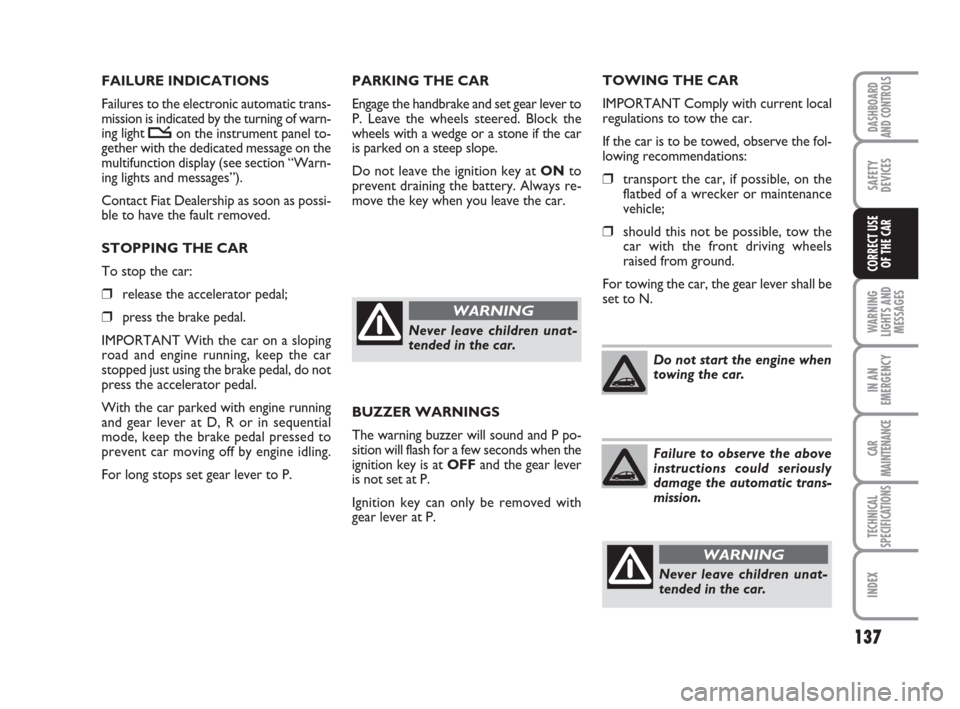
PARKING THE CAR
Engage the handbrake and set gear lever to
P. Leave the wheels steered. Block the
wheels with a wedge or a stone if the car
is parked on a steep slope.
Do not leave the ignition key at ONto
prevent draining the battery. Always re-
move the key when you leave the car.TOWING THE CAR
IMPORTANT Comply with current local
regulations to tow the car.
If the car is to be towed, observe the fol-
lowing recommendations:
❒transport the car, if possible, on the
flatbed of a wrecker or maintenance
vehicle;
❒should this not be possible, tow the
car with the front driving wheels
raised from ground.
For towing the car, the gear lever shall be
set to N. FAILURE INDICATIONS
Failures to the electronic automatic trans-
mission is indicated by the turning of warn-
ing light
ton the instrument panel to-
gether with the dedicated message on the
multifunction display (see section “Warn-
ing lights and messages”).
Contact Fiat Dealership as soon as possi-
ble to have the fault removed.
STOPPING THE CAR
To stop the car:
❒release the accelerator pedal;
❒press the brake pedal.
IMPORTANT With the car on a sloping
road and engine running, keep the car
stopped just using the brake pedal, do not
press the accelerator pedal.
With the car parked with engine running
and gear lever at D, R or in sequential
mode, keep the brake pedal pressed to
prevent car moving off by engine idling.
For long stops set gear lever to P.
137
WARNING
LIGHTS AND
MESSAGES
IN AN
EMERGENCY
CAR
MAINTENANCE
TECHNICAL
SPECIFICATIONS
INDEX
DASHBOARD
AND CONTROLS
SAFETY
DEVICES
CORRECT USE
OF THE CAR
Never leave children unat-
tended in the car.
WARNING
BUZZER WARNINGS
The warning buzzer will sound and P po-
sition will flash for a few seconds when the
ignition key is at OFFand the gear lever
is not set at P.
Ignition key can only be removed with
gear lever at P.Do not start the engine when
towing the car.
Failure to observe the above
instructions could seriously
damage the automatic trans-
mission.
Never leave children unat-
tended in the car.
WARNING
127-144 Croma TRW GB 28-05-2008 16:33 Pagina 137
Page 139 of 258
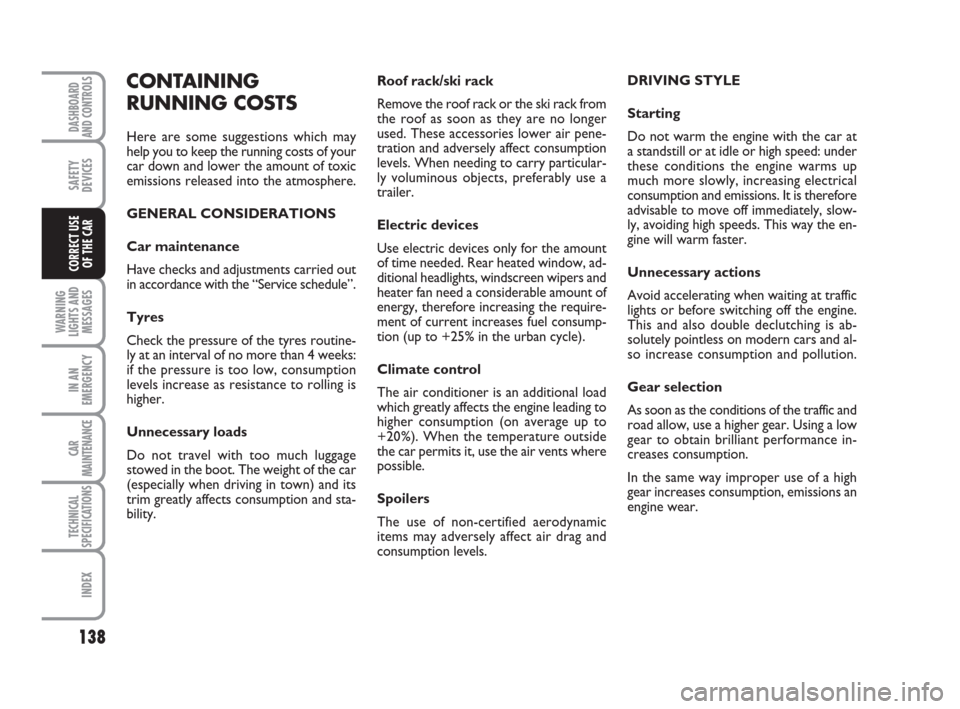
Roof rack/ski rack
Remove the roof rack or the ski rack from
the roof as soon as they are no longer
used. These accessories lower air pene-
tration and adversely affect consumption
levels. When needing to carry particular-
ly voluminous objects, preferably use a
trailer.
Electric devices
Use electric devices only for the amount
of time needed. Rear heated window, ad-
ditional headlights, windscreen wipers and
heater fan need a considerable amount of
energy, therefore increasing the require-
ment of current increases fuel consump-
tion (up to +25% in the urban cycle).
Climate control
The air conditioner is an additional load
which greatly affects the engine leading to
higher consumption (on average up to
+20%). When the temperature outside
the car permits it, use the air vents where
possible.
Spoilers
The use of non-certified aerodynamic
items may adversely affect air drag and
consumption levels.DRIVING STYLE
Starting
Do not warm the engine with the car at
a standstill or at idle or high speed: under
these conditions the engine warms up
much more slowly, increasing electrical
consumption and emissions. It is therefore
advisable to move off immediately, slow-
ly, avoiding high speeds. This way the en-
gine will warm faster.
Unnecessary actions
Avoid accelerating when waiting at traffic
lights or before switching off the engine.
This and also double declutching is ab-
solutely pointless on modern cars and al-
so increase consumption and pollution.
Gear selection
As soon as the conditions of the traffic and
road allow, use a higher gear. Using a low
gear to obtain brilliant performance in-
creases consumption.
In the same way improper use of a high
gear increases consumption, emissions an
engine wear.CONTAINING
RUNNING COSTS
Here are some suggestions which may
help you to keep the running costs of your
car down and lower the amount of toxic
emissions released into the atmosphere.
GENERAL CONSIDERATIONS
Car maintenance
Have checks and adjustments carried out
in accordance with the “Service schedule”.
Tyres
Check the pressure of the tyres routine-
ly at an interval of no more than 4 weeks:
if the pressure is too low, consumption
levels increase as resistance to rolling is
higher.
Unnecessary loads
Do not travel with too much luggage
stowed in the boot. The weight of the car
(especially when driving in town) and its
trim greatly affects consumption and sta-
bility.
138
WARNING
LIGHTS AND
MESSAGES
IN AN
EMERGENCY
CAR
MAINTENANCE
TECHNICAL
SPECIFICATIONS
INDEX
DASHBOARD
AND CONTROLS
SAFETY
DEVICES
CORRECT USE
OF THE CAR
127-144 Croma TRW GB 28-05-2008 16:33 Pagina 138
Page 140 of 258
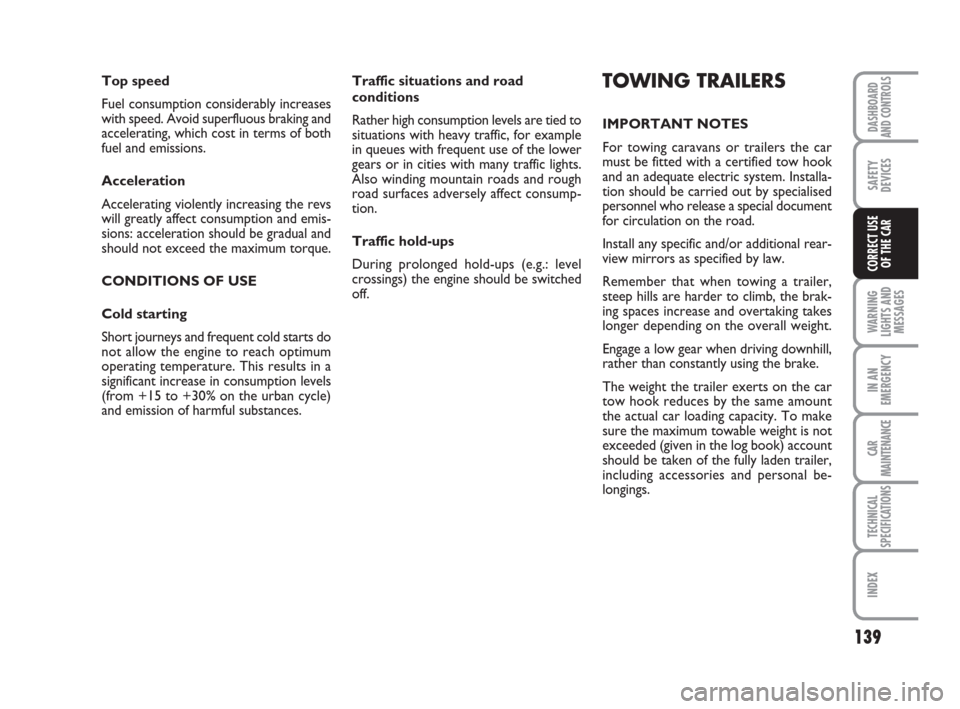
Traffic situations and road
conditions
Rather high consumption levels are tied to
situations with heavy traffic, for example
in queues with frequent use of the lower
gears or in cities with many traffic lights.
Also winding mountain roads and rough
road surfaces adversely affect consump-
tion.
Traffic hold-ups
During prolonged hold-ups (e.g.: level
crossings) the engine should be switched
off.TOWING TRAILERS
IMPORTANT NOTES
For towing caravans or trailers the car
must be fitted with a certified tow hook
and an adequate electric system. Installa-
tion should be carried out by specialised
personnel who release a special document
for circulation on the road.
Install any specific and/or additional rear-
view mirrors as specified by law.
Remember that when towing a trailer,
steep hills are harder to climb, the brak-
ing spaces increase and overtaking takes
longer depending on the overall weight.
Engage a low gear when driving downhill,
rather than constantly using the brake.
The weight the trailer exerts on the car
tow hook reduces by the same amount
the actual car loading capacity. To make
sure the maximum towable weight is not
exceeded (given in the log book) account
should be taken of the fully laden trailer,
including accessories and personal be-
longings. Top speed
Fuel consumption considerably increases
with speed. Avoid superfluous braking and
accelerating, which cost in terms of both
fuel and emissions.
Acceleration
Accelerating violently increasing the revs
will greatly affect consumption and emis-
sions: acceleration should be gradual and
should not exceed the maximum torque.
CONDITIONS OF USE
Cold starting
Short journeys and frequent cold starts do
not allow the engine to reach optimum
operating temperature. This results in a
significant increase in consumption levels
(from +15 to +30% on the urban cycle)
and emission of harmful substances.
139
WARNING
LIGHTS AND
MESSAGES
IN AN
EMERGENCY
CAR
MAINTENANCE
TECHNICAL
SPECIFICATIONS
INDEX
DASHBOARD
AND CONTROLS
SAFETY
DEVICES
CORRECT USE
OF THE CAR
127-144 Croma TRW GB 28-05-2008 16:33 Pagina 139
Page 141 of 258
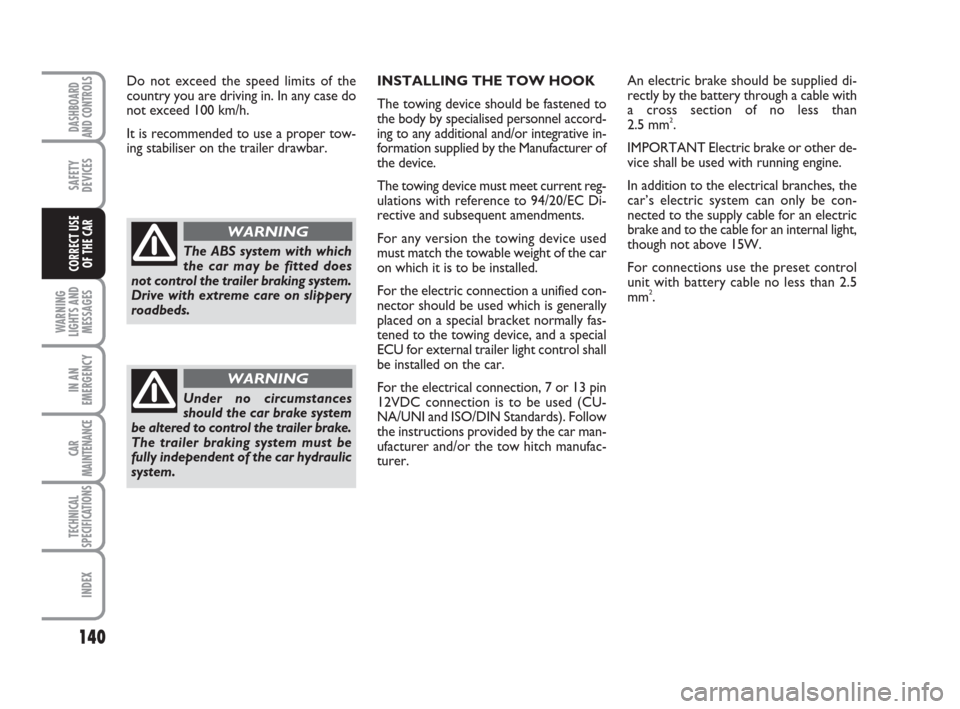
INSTALLING THE TOW HOOK
The towing device should be fastened to
the body by specialised personnel accord-
ing to any additional and/or integrative in-
formation supplied by the Manufacturer of
the device.
The towing device must meet current reg-
ulations with reference to 94/20/EC Di-
rective and subsequent amendments.
For any version the towing device used
must match the towable weight of the car
on which it is to be installed.
For the electric connection a unified con-
nector should be used which is generally
placed on a special bracket normally fas-
tened to the towing device, and a special
ECU for external trailer light control shall
be installed on the car.
For the electrical connection, 7 or 13 pin
12VDC connection is to be used (CU-
NA/UNI and ISO/DIN Standards). Follow
the instructions provided by the car man-
ufacturer and/or the tow hitch manufac-
turer.An electric brake should be supplied di-
rectly by the battery through a cable with
a cross section of no less than
2.5 mm
2.
IMPORTANT Electric brake or other de-
vice shall be used with running engine.
In addition to the electrical branches, the
car’s electric system can only be con-
nected to the supply cable for an electric
brake and to the cable for an internal light,
though not above 15W.
For connections use the preset control
unit with battery cable no less than 2.5
mm
2. Do not exceed the speed limits of the
country you are driving in. In any case do
not exceed 100 km/h.
It is recommended to use a proper tow-
ing stabiliser on the trailer drawbar.
140
WARNING
LIGHTS AND
MESSAGES
IN AN
EMERGENCY
CAR
MAINTENANCE
TECHNICAL
SPECIFICATIONS
INDEX
DASHBOARD
AND CONTROLS
SAFETY
DEVICES
CORRECT USE
OF THE CAR
The ABS system with which
the car may be fitted does
not control the trailer braking system.
Drive with extreme care on slippery
roadbeds.
WARNING
Under no circumstances
should the car brake system
be altered to control the trailer brake.
The trailer braking system must be
fully independent of the car hydraulic
system.
WARNING
127-144 Croma TRW GB 28-05-2008 16:33 Pagina 140
Page 142 of 258
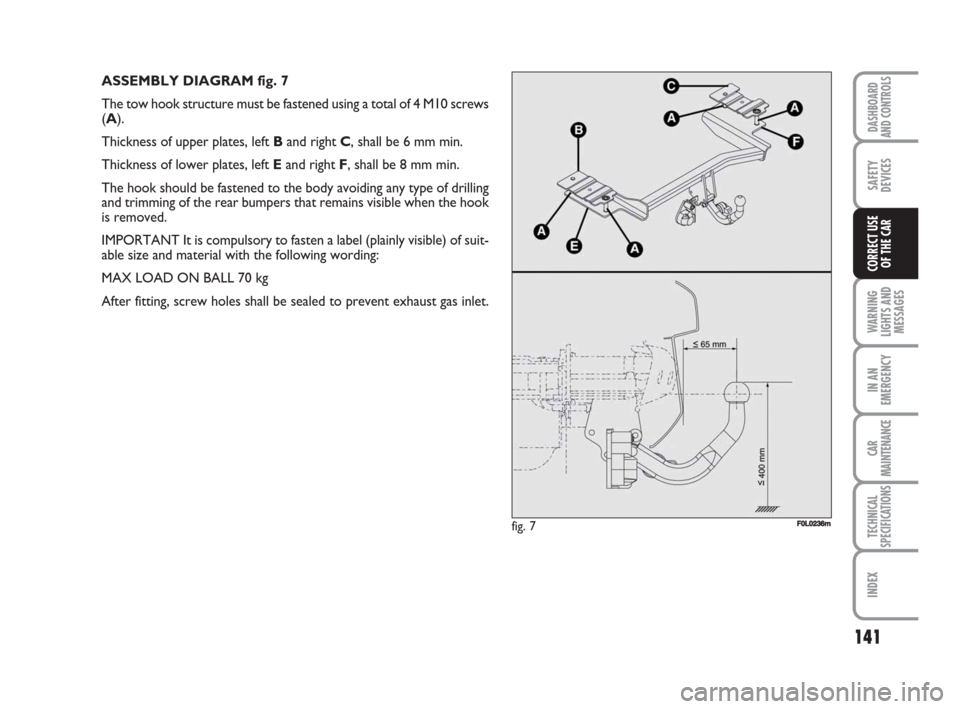
ASSEMBLY DIAGRAM fig. 7
The tow hook structure must be fastened using a total of 4 M10 screws
(A).
Thickness of upper plates, left Band right C, shall be 6 mm min.
Thickness of lower plates, left Eand right F, shall be 8 mm min.
The hook should be fastened to the body avoiding any type of drilling
and trimming of the rear bumpers that remains visible when the hook
is removed.
IMPORTANT It is compulsory to fasten a label (plainly visible) of suit-
able size and material with the following wording:
MAX LOAD ON BALL 70 kg
After fitting, screw holes shall be sealed to prevent exhaust gas inlet.
141
WARNING
LIGHTS AND
MESSAGES
IN AN
EMERGENCY
CAR
MAINTENANCE
TECHNICAL
SPECIFICATIONS
INDEX
DASHBOARD
AND CONTROLS
SAFETY
DEVICES
CORRECT USE
OF THE CAR
fig. 7FF0L0236m
127-144 Croma TRW GB 28-05-2008 16:33 Pagina 141
Page 143 of 258

IMPORTANT When snow tyres are used
with a max speed index below the one
that can be reached by the car (increased
by 5%), place a notice in the passenger’s
compartment, plainly in the driver’s view
which states the max permissible speed of
the snow tyres (as per EC Directive).
All four tyres should be the same (brand
and track) to ensure greater safety when
driving and braking and better driveabili-
ty.
Remember that it is inappropriate to
change the direction of rotation of tyres.SNOW TYRES
Use snow tyres of the same size as the
normal tyres provided with the car.
Fiat Dealership will be happy to provide
advice concerning the most suitable type
of tyre for the customer’s requirements.
For the type of tyre to be used, inflation
pressures and the specifications of snow
tyres, follow the instructions given in para-
graph “Wheels” in section “Technical
specifications”.
The winter features of these tyres are re-
duced considerably when the tread depth
is below 4 mm. In this case, they should
be replaced.
Due to the snow tyre features, under nor-
mal conditions of use or on long motor-
way journeys, the performance of these
tyres is lower than that of normal tyres. It
is therefore necessary to limit their use to
the purposes for which they are certified.
142
WARNING
LIGHTS AND
MESSAGES
IN AN
EMERGENCY
CAR
MAINTENANCE
TECHNICAL
SPECIFICATIONS
INDEX
DASHBOARD
AND CONTROLS
SAFETY
DEVICES
CORRECT USE
OF THE CAR
The max speed for snow
tyres with “Q” marking is
160 km/h; 190 km/h for tyres with “T”
marking and 210 km/h for tyres with
H marking. The Road Traffic Code
speed limits must however be always
strictly observed.
WARNING
127-144 Croma TRW GB 28-05-2008 16:33 Pagina 142
Page 144 of 258
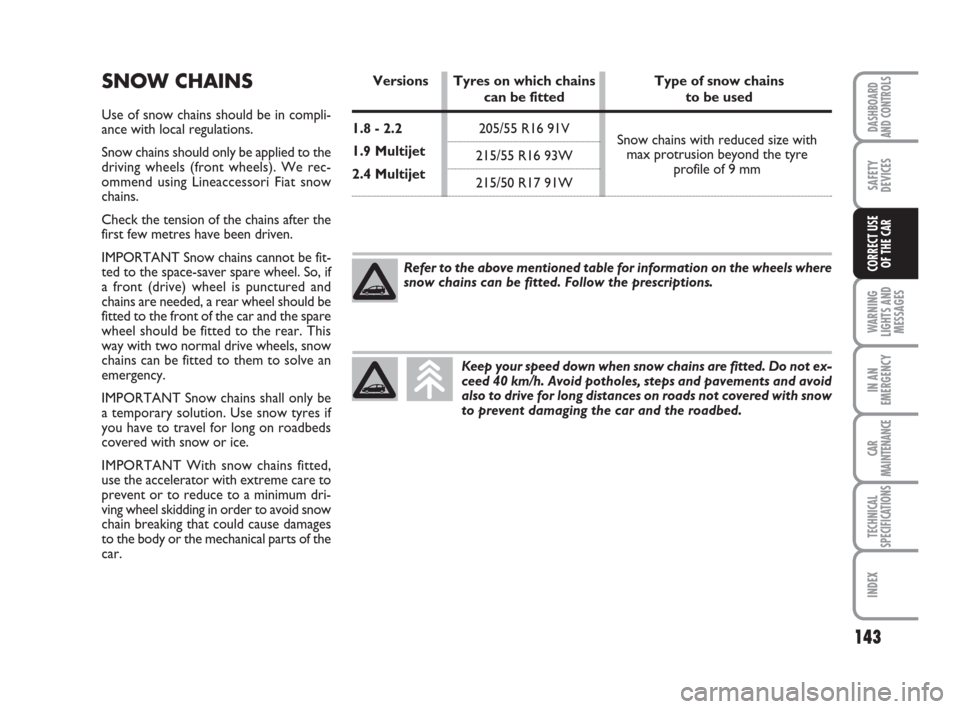
SNOW CHAINS
Use of snow chains should be in compli-
ance with local regulations.
Snow chains should only be applied to the
driving wheels (front wheels). We rec-
ommend using Lineaccessori Fiat snow
chains.
Check the tension of the chains after the
first few metres have been driven.
IMPORTANT Snow chains cannot be fit-
ted to the space-saver spare wheel. So, if
a front (drive) wheel is punctured and
chains are needed, a rear wheel should be
fitted to the front of the car and the spare
wheel should be fitted to the rear. This
way with two normal drive wheels, snow
chains can be fitted to them to solve an
emergency.
IMPORTANT Snow chains shall only be
a temporary solution. Use snow tyres if
you have to travel for long on roadbeds
covered with snow or ice.
IMPORTANT With snow chains fitted,
use the accelerator with extreme care to
prevent or to reduce to a minimum dri-
ving wheel skidding in order to avoid snow
chain breaking that could cause damages
to the body or the mechanical parts of the
car.
143
WARNING
LIGHTS AND
MESSAGES
IN AN
EMERGENCY
CAR
MAINTENANCE
TECHNICAL
SPECIFICATIONS
INDEX
DASHBOARD
AND CONTROLS
SAFETY
DEVICES
CORRECT USE
OF THE CAR
Versions Tyres on which chains Type of snow chains
can be fitted to be used
1.8 - 2.2205/55 R16 91V
1.9 Multijet
215/55 R16 93W
2.4 Multijet
215/50 R17 91WSnow chains with reduced size with
max protrusion beyond the tyre
profile of 9 mm
Refer to the above mentioned table for information on the wheels where
snow chains can be fitted. Follow the prescriptions.
Keep your speed down when snow chains are fitted. Do not ex-
ceed 40 km/h. Avoid potholes, steps and pavements and avoid
also to drive for long distances on roads not covered with snow
to prevent damaging the car and the roadbed.
127-144 Croma TRW GB 28-05-2008 16:33 Pagina 143